The splendid city of Istanbul has many unique and fascinating features. It is the only city in the world reaching across two continents, with its old city in Europe and modern Istanbul situated in Asia, separated by the Bosphorus Strait. It is also unique in having had capital status during two successive empires, Christian Byzantine and Islamic Ottoman, and the legacy from both is visible in the modern city today.
Istanbul's location on the water made it a much coveted site as a commercial shipping port and military lookout, and as capital of the Roman Empire, Constantinople, as it was known, became extremely desirable as a centre of world trade, until Mehmet the Conqueror claimed it for the Ottoman Empire in 1453 and it became the imperial seat of the sultans. After the War of Independence the capital was moved to Ankara, but Istanbul still remains the commercial, historical and cultural heart of Turkey today.
The charm and character of Istanbul lies in its endless variety and jumble of contradictions. Its fascinating history has bequeathed the city a vivid inheritance of Byzantine ruins, splendid palaces, ancient mosques and churches, hamams (bath-houses) and exotic bazaars. Modern Istanbul exudes trendy bars and nightclubs, western boutiques, office blocks, and elegant suburbs. The call to prayer heralds the start of each day and the city comes to life with over 11 million residents forming a chaotic social and cultural mix of unscrupulous carpet merchants, wealthy shoppers, religiously veiled women and destitute beggars. Joining the noisy throng are over-awed tourists and those capitalising on the tourist trade.
Attractions
| Famous for its impressive size, remarkable architecture and beautiful mosaics and frescoes, the massive ochre-coloured domed structure known as Hagia Sophia is one of Istanbul's most popular attractions. It was commissioned as a cathedral in the 6th century and remained the most important church in Christianity for over 900 years. In the 15th century Mehmet II conquered the city and converted it into a mosque, adding the minarets and fountains. It functioned as such for the next 481 years until the founding of the secular Turkish Republic in 1934 when it was declared a museum. Hagia Sophia is one of the greatest Byzantine buildings in the world, and the vast interior, with its huge soaring dome, is extraordinary. The interior contains different features from its time as a cathedral and then as a mosque, including incredible Byzantine mosaics, icons and marble columns, a mihrab (niche indicating the direction of Mecca), and Islamic calligraphy inscriptions on the dome from the Ottoman period. | | 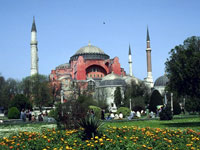 |
| Covered Bazaar (Kapali Çarsi) |
| The oldest and biggest enclosed bazaar in the world, also known as the Grand Bazaar, is one of the most enticing and mesmerizing attractions in Istanbul. Consisting of a vast labyrinth of 65 twisting streets crammed with more than 4,000 shops, teahouses, hamams (Turkish baths), mosques, storehouses and fountains. It is a fascinating experience to wander around the alleyways, looking and enjoying, or bargaining and purchasing. Here you can find almost anything, from meerschaum pipes, carpets and jewellery, to Turkish Delight, textiles, spices, clothing and hand-painted ceramics. Protracted bargaining over a cup of tea is an important institution. Built during the rule of Sultan Mehmet the Conqueror in 1461, the bazaar grew by covering an increasingly large area of shops and streets with roofs, arches and domes, and it became the centre of trading during the Ottoman period. Caravans of silk traders traditionally stayed here and rested their camels while selling their merchandise, and many of these 'hans' or caravanserais still exist as storehouses today. | | 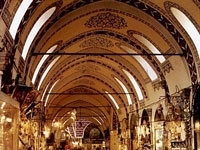 |
| Blue Mosque (Sultan Ahmet Camii) |
| The Sultan Ahmet Camii, commonly known as the Blue Mosque, with its tiers of magnificent domes and six graceful minarets is one of the most striking and immediately distinguishable structures on the Istanbul's skyline. Constructed as an Islamic rival to the Hagia Sophia in 1609, it is one of the finest examples of Ottoman architecture and is still used by hundreds of worshippers. The interior is splendidly decorated with thousands of blue and white Iznik tiles embellished with traditional Ottoman flower patterns, and it is this special feature that gives the mosque its name. Its design of successively descending smaller domes, soaring columns and 260 stained glass windows leaves a lasting impression of graceful accord and open space. At the back of the mosque is a Carpet and Kilim Museum exhibiting antiques from all over Turkey. | | 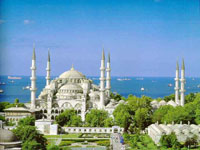 |
| Turkish and Islamic Art Museum |
| The grand 16th century palace of the sultan's Grand Vizier, Ibrahim Pasa, today houses the Turkish and Islamic Art Museum, containing what many consider to be the finest collection of Islamic artefacts in the world. The palace itself was the finest private residence ever built in the Ottoman Empire. From its supreme position overlooking the Hippodrome, the sultan could enjoy excellent views of the celebrations in the square below. The museum is well laid out and contains more than 40,000 examples of Selçuk, Mamluk and Ottoman Turkish art, including ceramics, Koran cases, calligraphy, textiles, metalwork and illuminated manuscripts. Its antique carpet exhibit is renowned; the carpets, kilims and prayer rugs forming one of the richest and oldest collections in the world. | | 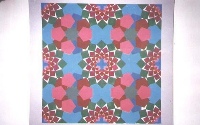 |
| The Topkapi Sarayi, built by Mehmet the Conqueror as a Sultan's Palace, consists of a sprawling collection of buildings arranged around several interconnecting courtyards. Magnificently situated on one of the seven hills of Istanbul with uninterrupted views over the Bosphorus River and the Golden Horn, it was the seat of the Ottoman Empire for almost four centuries. Home to nearly 3,000 people, it served as royal residence, harem, state administration and military barracks. One of the most popular sections is the harem, once the quarters of about 300 women who were the sultans' wives and concubines, and their children. Visitors can view the apartments, halls and terraces of the harem, and see the lavish royal bedchamber and Imperial Hall. No expense was spared in decorating the palace and exquisitely designed rooms, intricately detailed fountains and gateways, and the splendid Treasury, housing one of the greatest collections of treasure in the world, afford insight into the opulent lifestyle of the sultans of the Ottoman Empire. |
| 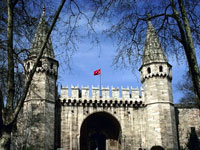 |
| Also known as the Underground Cistern or Yerebatan Saray, this eerie cavern was built by Constantinople the Great around 532 AD and is held up below ground by 336 columns. Once a set for the James Bond film, From Russia with Love, the cavern today sees tourists crossing over 2 acres of 12 inch deep water, on wooden walkways, to take in the occasional art exhibit or marvel at the intricate design on the columns themselves. There is a pleasant little café topside where the eyes can adjust over some tea. | | 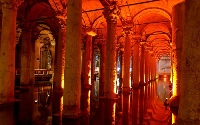 |
| Erected as a bastion for the walls of the 14th century colony of Galata, the tower offers a 360º panoramic view of the old town. Today it is a sought-after conference venue, offering fine dining at the resident restaurant and belly dancing displays in its own night club. | | 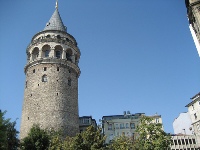 |
| This second palace of the Ottoman Sultans was once the Sultan's harem and is an ostentatious interior of crystal chandeliers, the one adorning the grand hall weighing in at four tons (4,000 kg). On the exterior, the palace has an extensive and beautiful garden, yours for the strolling. | | 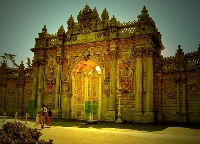 |
| Kids on holiday in Istanbul will jump at a chance to visit the dolphinarium, its six pools home to a few dolphins and seals, as well as white whales and walruses. Children can swim with the dolphins, visit the toy store and learn many great sea-life facts while they're there. The restaurant or café are great for a snack or lunch break. |
| 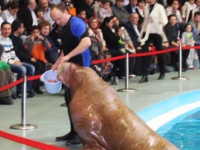 |
| The fascinating world of science can be explored by children at the Sisli science centre in Istanbul. Interactive programs and animations cover a range of subjects from maths and physics to earthquakes and fire-fighting. Take a ride on the Bouncing Electrons or see the destructive force of a 7.4 magnitude earthquake. |
|  |
| Discovery Sphere Planetarium |
| In a true space odyssey, kids can marvel at the wonders of the universe projected onto the walls of the Discovery Sphere Planetarium. They will be amazed at the night sky as it reveals infinite stars and the fascinating Milky Way. All children's space questions will be answered by the planetarium's friendly on-site specialists or the latest digital animation systems. |
|  |
| The ancient Hippodrome of Constantinople was built between 200 and 300 as a stadium for horse racing, chariot racing, and other amusements. Seating up to 100,000 people, there isn't much remaining of the structure today. Now the site of the Hippodrome in Istanbul is a beautiful public park with a few remaining columns hinting at its grand past. The Obelisk of Tutmosis III, the Basilica Cistern, the Fountain of Wilhelm II, and the Serpentine and Constantine Columns are popular landmarks within the park, which also offers free wireless internet. | | 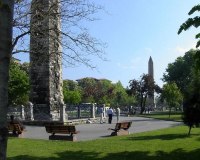 |
Events
Istanbul - LutfiKýrdar Istanbul Convention and Exhibition Centre
Every October artists from all across Turkey converge on the capital to showcase their latest creations in contemporary art. A variety of paintings, sculpture and crafts are displayed for exhibition purposes and also for sale. Admirers from all across Turkey show up for the week to assess, purchase and critique the latest offerings of a fascinating culture.
24-27 November 2011 | | 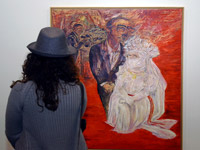 |
Istanbul - Istanbul Park
One of the newer tracks added to the Formula One Season, Istanbul Park has been described as 'The greatest track ever built', by Bernie Ecclestone, CEO of the Formula One Administration. It is one of only three races that runs anticlockwise (the Brazillian and San Marino Grand Prix being the other two) and commands the respect of all the drivers. The track is located 56 miles (90km) from the city centre.
6 - 8 May 2011 | |  |
| International Istanbul Music Festival |
Istanbul - Various
One of the most prominent events on the city's cultural calendar and one of the foremost musical events in Europe, the International Istanbul Music Festival is a summer extravaganza of opera and ballet, as well as classical and traditional music. Over the years the festival has hosted world-renown classical performers and groups from around the globe, as well as local artists and traditional music groups, from international philharmonic orchestras, distinguished chamber ensembles and soloists to dance and ballet performances and Whirling Dervishes. Concerts are held in various locations, including some of the historical buildings in Istanbul.
4 - 29 June 2011 | |  |
Istanbul - Kanlica
This annual event sees over a thousand swimmers navigate the 4.3 miles (7km) of the Bosphorus Straight between Kanlica and Cemil Topuzlu Park, essentially swimming from Asia to Europe. Concurrently, rowers and sailors participate in longer races along the same route. Complementing the event are live brass band performances, water-ski exhibitions and dance performances.
17 July 2011
| | 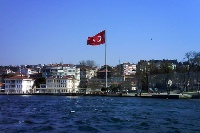 |
















No comments:
Post a Comment